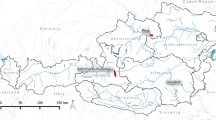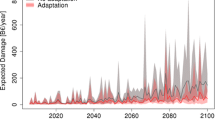Abstract
Climate change and sea level rise urge low-lying countries to draft adaption policies. In this context, we assessed whether, to what extent and when the Netherlands’ current flood risk management policy may require a revision. By applying scenarios on climate change and socio-economic development and performing flood simulations, we established the past and future changes in flood probabilities, exposure and consequences until about 2050. We also questioned whether the present policy may be extended much longer, applying the concept of ‘policy tipping points’. Climate change was found to cause a significant increase of flood risk, but less than economic development does. We also established that the current flood risk management policy in the Netherlands can be continued for centuries when the sea level rise rate does not exceed 1.5 m per century. However, we also conclude that the present policy may not be the most attractive strategy, as it has some obvious flaws.








Similar content being viewed by others
References
Botzen, W.J.W., J.C.J.M. van den Bergh, and L.M. Bouwer. 2010. Climate change and increased risk for the insurance sector: a global perspective and an assessment for the Netherlands. Natural Hazards 52: 577–598.
Bouwer, L.M., P. Bubeck, and J.C.J.H. Aerts. 2010. Changes in future flood risk due to climate and development in a Dutch polder area. Global Environmental Change 20: 463–471.
CHR/KHR. 2010. Assessment of climate change impacts on discharge in the Rhine River Basin: Results of the RheinBlick2050 Project. Report no. I-23 of the CHR.
Claessen, F., C. van de Guchte, H. van der Most, W. Oosterberg, and R. Portielje. 2009. How do other countries adapt to climate change? International survey of climate adaptation, especially in water management policy. Deltares report T2586, Utrecht (in Dutch).
De Bruijn, K.M., F. Klijn, C. McGahey, M. Mens, and H. Wolfert. 2008. Long-term strategies for flood risk management: Scenario definition and strategy design. FLOODsite report T14-08-01.
De Bruijn, K.M., R. van Buren, and K. Roscoe. 2008a. Mapping casualty risk in the Netherlands; locational and group risk. Deltares report T2603, Delft.
De Bruijn, K.M., and F. Klijn. 2009. Risky places in the Netherlands: A first approximation for floods. Journal for Flood Risk Management 7: 58–67.
Delta Committee. 2008. Working together with water. A vital country builds its future. The Hague: Delta Committee (in Dutch).
Eijgenraam, C.J.J. 2006. Optimal safety standards for dike-ring areas. CPB discussion paper 62. Den Haag: CPB.
Evans, E.M., R. Ashley, J. Hall, E. Penning-Rowsell, A. Saul, P. Sayers, C. Thorne, and A. Watkinson. 2004. Foresight. Future flooding. Scientific summary: Volume I—future risks and their drivers. London, UK: Office of Science and Technology.
FLOODsite. 2009. Flood risk assessment and flood risk management. An introduction and guidance based on experiences and findings of FLOODsite (an EU-funded Integrated Project). Delft, The Netherlands: Delft Hydraulics, Deltares. ISBN 978 90 814067 1 0. http://www.floodsite.net.
Haasnoot, M., H. Middelkoop, E. van Beek, and W.P.A. van Deursen. 2009. A method to develop sustainable water management strategies for an uncertain future. Sustainable Development. doi:10.1002/sd.438.
Hesselink, A.W., G.S. Stelling, J.C.J. Kwadijk, and H. Middelkoop. 2003. Inundation of a Dutch river polder, sensitivity analysis of a physically based inundation model using historic data. Water Resources Research 39: 1234. doi:10.1029/2002WR001334.
IPCC. 2001. Climate change 2001: The scientific basis, contribution of working group I to the third assessment report of the intergovernmental panel on climate change. Cambridge: Cambridge University Press.
IPCC. 2007. Climate change 2007: The physical science basis. Contribution of working group I to the fourth assessment report of the intergovernmental panel on climate change. Cambridge: Cambridge University Press.
Jonkman, S.N., M. Brinkhuis-Jak, and M. Kok. 2004. Cost benefit analysis and flood damage mitigation in the Netherlands. HERON 49: 95–111.
Klijn, F., H. van der Klis, J. Stijnen, K.M. de Bruijn, and M. Kok. 2004a. Flood risk in dike-ring areas in the Netherlands; line of reasoning and expert judgments. Delft Hydraulics report Q3503.10, Delft (in Dutch).
Klijn, F., M. van Buuren, and S.A.M. van Rooij. 2004b. Flood risk management strategies for an uncertain future: living with Rhine River floods in the Netherlands? Ambio 33: 141–147.
Klijn, F., P. Baan, K.M. de Bruijn, and J. Kwadijk. 2007. Flood risks in the Netherlands in a changing climate; expectations, estimates and calculations for the 2nd sustainability outlook for the Netherlands. Delft Hydraulics report Q4290, Delft (in Dutch).
Klijn, F., J. Kwadijk, K.M. de Bruijn, and J. Hunink. 2010a. Flood risks and drought risks in a changing climate; survey of pathways to climate-change proofing the Netherlands. Deltares report 1002565, Delft (in Dutch).
Klijn, F., N. Asselman, and H. van der Most. 2010b. Compartmentalisation: Flood consequence reduction by splitting-up large polder areas. Journal of Flood Risk Management 3: 3–17. doi:10.1111/j.1753-318X.2009.01047.x.
KNMI. 2006. KNMI climate change scenarios 2006 for the Netherlands. KNMI scientific report WR 2006-01, De Bilt.
Koomen, E., and E.M.M.M. van der Hoeven. 2008. The Netherlands climate proof; what will the country look like in 2040? Geoinformatics 11: 26–27.
Kuiper, R., and A.A. Bouwman. 2009. Trend map Netherlands 2040. Background report for the 2nd sustainability outlook. PBL publication no. 500074006, Bilthoven (in Dutch).
Kwadijk, J., F. Klijn, and M. van Drunen. 2006. Climate durability of the Netherlands: benchmark assessment. Delft Hydraulics report Q4183, Delft (in Dutch).
Kwadijk, J., A. Jeuken, and H. van Waveren. 2008. The climate durability of the Netherlands Waterland. Survey of tipping points in water management and policy. Deltares report T2447, Delft (in Dutch).
Kwadijk J.C.J., M. Haasnoot, J. Mulder, M. Hoogvliet, A. Jeuken, R. van de Krogt, N. van Oostrom, H. Schelfhout, E. van Velzen, H. van Waveren, and M. de Wit. 2010. Using adaptation tipping points to prepare for climate change and sea level rise: a case study in the Netherlands. WIREs Climate Change 2010 1 000–000. doi:10.1002/wcc.64.
Kwakkel, J.H., W.E. Walker, and V.A.W.J. Marchau. 2010. Classifying and communicating uncertainties in model-based policy analysis. International Journal of Technology, Policy and Management 10: 299–315.
Lammersen, R. 2004. Cross-boundary impacts of extreme floods of the Lower Rhine River. Ministerium für Umwelt und Naturschutz, Landwirtschaft und Verbraucherschutz des Landes Nordrhein-Westfalen. ISBN 9036956382 (in German).
Lindström, G., M. Gardelin, B. Johansson, M. Persson, and S. Bergström. 1997. Development and test of the distributed HBV-96 hydrological model. Journal of Hydrology 201: 272–288.
Maaskant, B., S.N. Jonkman, and L.M. Bouwer. 2009. Future risk of flooding: an analysis of changes in potential loss of life in South Holland (The Netherlands). Environmental Science and Policy 12: 157–169.
Passchier, R., F. Klijn, and H. Holzhauer. 2009. Policy tipping points in the southwestern estuarine region? Survey of climate-change durability. Deltares report 1200163-006, Delft (in Dutch).
Samuels, P., and B. Gouldby. 2009. Language of risk. Project definitions, 2nd ed. Report T32-04-01. http://www.floodsite.net.
Samuels, P., F. Klijn, and J.P.M. Dijkman. 2006. An analysis of the current practice of policies on river flood risk management in different countries. Irrigation and Drainage 55: 141–150.
Te Linde, A.H., J.C.J.H. Aerts, A.M.R. Bakker, and J.C.J. Kwadijk. 2010. Simulating low-probability peak discharges for the Rhine basin using resampled climate modeling data. Water Resources Research 46: W03512. doi:10.1029/2009WR007707.
Ten Brinke, W., and B. Bannink. 2005. Flood risk: An evaluation of the flood risk management policy. Bilthoven (in Dutch): RIVM- MNP.
Van Danzig, D. 1956. Economic decision problems for flood prevention. Econometrica 24: 276–287.
Van Deursen, W.P.A. 2006. Report Rhineflow/Meuseflow. New KNMI climate change scenarios. Rotterdam (in Dutch): Carthago Consultancy.
Vellinga, P., C.A. Katsman, A. Sterl, and J.J. Beersma (eds.). 2009. Exploring high-end climate change scenarios for flood protection of the Netherlands. KNMI Scientific report WR-2009-05, De Bilt.
Acknowledgments
The writing of this article was subsidized by the Netherlands’ research program Knowledge for Climate (Theme 1: Climate-proof Flood Risk Management) and is partly based on research within the Integrated Project FLOODsite (EU-6th Framework Programme, Contract GOCE-CT-2004-505420).
Author information
Authors and Affiliations
Corresponding author
Rights and permissions
About this article
Cite this article
Klijn, F., de Bruijn, K.M., Knoop, J. et al. Assessment of the Netherlands’ Flood Risk Management Policy Under Global Change. AMBIO 41, 180–192 (2012). https://doi.org/10.1007/s13280-011-0193-x
Received:
Revised:
Accepted:
Published:
Issue Date:
DOI: https://doi.org/10.1007/s13280-011-0193-x




